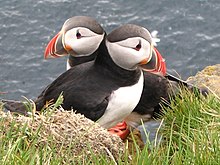This article includes a list of general references, but it lacks sufficient corresponding inline citations. (August 2019) |


The avifauna of Ireland included a total of 522 species as of the end of 2019 according to the Irish Rare Birds Committee (IRBC).[1] Of them, 183 are rare, and 14 of the rarities have not been seen in Ireland since 1950. Three species were either introduced to Ireland or came to Ireland from another introduced population.
Ireland has a relatively low diversity of breeding birds due to its isolation. Several species such as the tawny owl, Eurasian nuthatch and willow tit which breed in Great Britain have not been recorded. However, there are large colonies of seabirds including important populations of European storm-petrels, northern gannets, and roseate terns. Other notable breeding birds include corn crakes and red-billed choughs. There are no endemic species but there are endemic subspecies of white-throated dipper, coal tit, and Eurasian jay.
Large numbers of wildfowl and waders winter in Ireland, attracted by its mild climate. About half the world population of the Greenland race of greater white-fronted geese spend the winter there. During autumn, many migrating seabirds can be seen off the coasts including several species of skuas, shearwaters, and petrels. Ireland's westerly position means that North American birds are regularly recorded in autumn.
This list's taxonomic treatment (designation and sequence of orders, families and species) and nomenclature (English and scientific names) are those of the International Ornithological Congress (IOC) as of July 2021.[2] Many of the Irish names are taken from the National Terminology Database for Irish.[3]
The following A, B, and C tags are used by the IRBC to define the status of species. "R" is used here for rare species. The list does not include species placed in "Category D" by the IRBC. These are species where there is doubt as to whether they have occurred in a wild state (Category D1), they have arrived by human assistance such as on board a ship (D2), they have only been recorded dead on the tideline (D3), or they are feral species whose populations may not be self-sustaining (D4). Some species have records of individuals in more than one category; the "highest" category is listed here in those cases.
- A - "Species that have been recorded in an apparently natural state in Ireland at least once since 1st January 1950."
- B - "Species that have been recorded in an apparently natural state in Ireland at least once up to 31st December 1949, but have not been recorded subsequently." i.e. old vagrant records and/or extirpated species.
- C - "Species that, although originally introduced by man, have established feral breeding populations in Ireland which apparently maintain themselves without necessary recourse to further introduction [and species] that have occurred, but are considered to have originated from established naturalised populations outside Ireland."
- R - Species on IRBC Appendix 1, those "requiring substantiating details", i.e. rarities.
- ^ "Irish List covering the whole of Ireland on 31st Dec 2019" (PDF). Irish Rare Birds Committee. 31 December 2019. Retrieved 16 July 2020.
- ^ Gill, F.; Donsker, D.; Rasmussen, P. (July 2021). "IOC World Bird List (v 11.2)". Retrieved 14 July 2021.
- ^ "The National Terminology Database for Irish". téarma.ie.